The Palestinian Arena: Reshuffling the Cards
Udi Dekel, Anat Kurz, and Noa Shusterman
The Palestinian Arena: Reshuffling the Cards
Udi Dekel, Anat Kurz, and Noa Shusterman
Summary chart
Current Situation
Following escalation in the West Bank in 2022, volatility has increased · Weaker PA · Hamas has grown stronger
Current Israeli Strategy
New government’s policy lines depart from the strategy that prevailed until now · Postpone weighty decisions · Maintain a calm security situation for as long as possible
Israel’s Strategic Gap
Focus on conflict management with no effort toward a future agreement · Palestinian burden on Israel increases · Time is a critical vector in the slide toward a one-state reality
Strategic Alternatives
- Manage conflict and prevent escalation, by maintaining status quo on Temple Mount, refraining from annexation measures, and strengthening PA and Palestinian economy
- Begin to implement political, geographic and demographic separation steps from the Palestinians and refrain from expanding settlements outside the blocs
- Strengthen Israeli sovereignty on the Temple Mount and control of Area C and maintain differentiation between West Bank and Gaza Strip
Recommended Strategy
Short term: curb escalation and prevent dissolution of the PA · Long term: prevent a slide into a one-state reality through separation steps and regional, international assistance to build functioning Palestinian entity
Recommended Action
Complete the security barrier · Maintain IDF operational freedom · Strengthen the performance of Palestinian security apparatuses · Formulate a plan for the settlement blocs and reduce construction beyond them · Draft plan for Palestinian infrastructure in Area C · Create conditions for Palestinian economic growth · Include the PA in regional projects · Continue understandings with Hamas on calm in the Gaza Strip
The Strategic Problem: A Cycle of Conflict with No Way Out
For the past decade and a half, the Israeli strategic objective regarding the conflict with the Palestinians has been to buy time – although it was not clear for what purpose – and to establish a calm security situation for as long as possible. In practice, this meant managing the conflict without any attempt to strive for an agreement. Some have adopted the idea of “shrinking the conflict,” which is also a means of buying time and postponing weighty decisions. Central among them is how to remove the Palestinian burden from the State of Israel. But time is a critical vector in the trend of the slow but sure slide toward a reality of one state between the Mediterranean Sea and the Jordan River.
The past year was marked by rising violence and by a radicalization of the discourse on both sides. The respective leaderships are reluctant to take critical decisions that are relevant to the advance of an agreement, and this has led to both a political dead end and fertile ground for the escalation of violence and terrorism. The stalemate is the result of salient developments over the years, led by repeated failures to reach a comprehensive agreement; the split in the Palestinian camp between Fatah and Hamas; the acceptance in Israel of the narrative that there is no partner on the Palestinian side for an agreement; the increasing weakness of the Palestinian Authority and its loosening control over its territory; and waves of terrorism and violent clashes. All these have led the Israeli public, as well as ranks of decision makers, to lose confidence in the potential to advance an agreement on the conflict in the spirit of a two-state solution. However, the lack of progress toward a solution and the two sides being forced to manage the conflict deepen the entanglement between the populations and the complexity of the arena, to the extent that in the future it will not be possible to shape a reality of two state entities, Jewish and Palestinian, that will be distinct and separate politically, geographically, and demographically. In short, this is a threat to the character of the State of Israel as a Jewish, democratic, secure, and prosperous state.
Leading Trends in Early 2023
The past year was marked by heightened terrorism, mainly in the West Bank, which caused the largest number of victims in the past ten years. The IDF reported over 300 incidents of terrorism in 2022 – three times more than the previous year. The main challenge today is the growing security threat in the northern West Bank, which threatens to spread to Jerusalem and elsewhere in the territories. In 2022, 31 Israelis were murdered, and 154 Palestinians were killed (as of December 21, 2022, according to OCHA) in encounters with IDF forces. Israeli security forces thwarted 330 shooting attacks, 54 stabbing attacks, and about 30 attempts to place explosive devices: the dual attack in Jerusalem in late November involving explosive devices was an unfortunate exception to the successful preventive activity against such attacks.
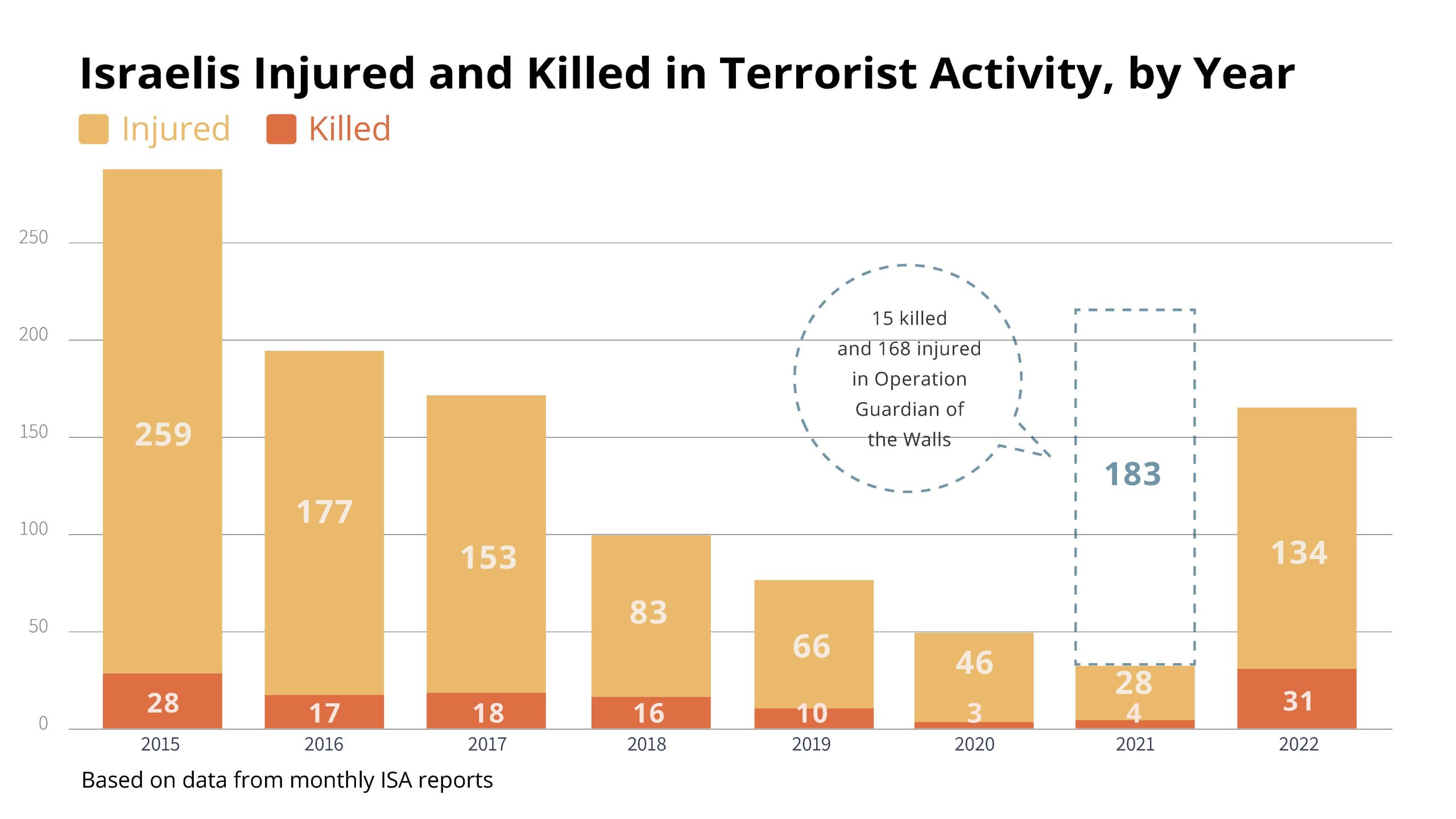
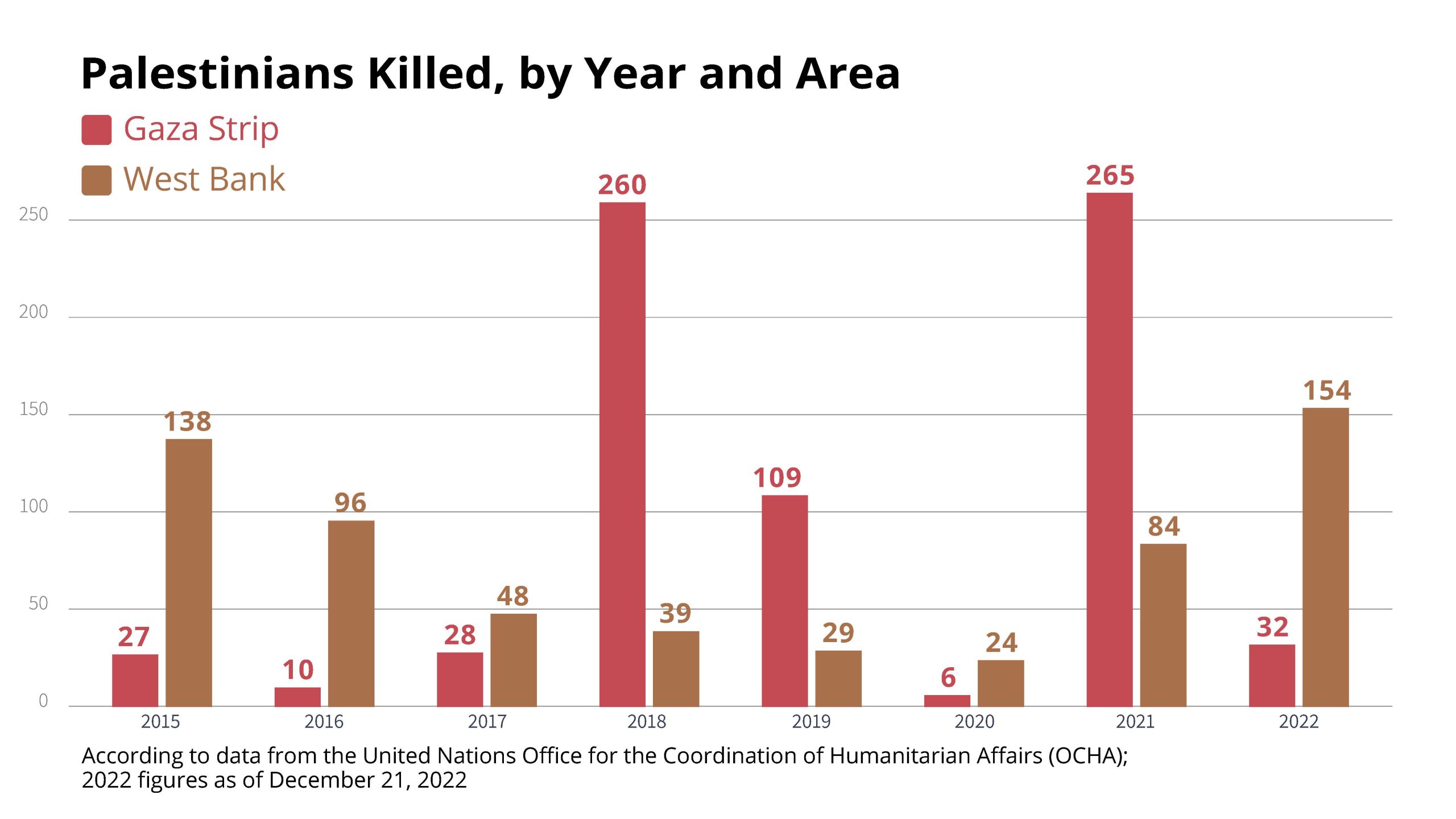
The wave of terrorism stems from the process of disintegration of the Palestinian Authority (PA), the loss of its legitimacy among the Palestinian public, and the vanished hope of ending the occupation. Led by young Palestinians who have penetrated the governmental vacuum, the violence compounds the helplessness of the Palestinian security forces and their lack of motivation to prevent attacks (due to their image among the Palestinian public as collaborators with the IDF); the availability of weapons, either stolen in Israel or smuggled from Jordan; and the glorification in Palestinian society of martyrs and resistance. The vigorous offensive by the Israeli security establishment in Operation Break the Wave, especially in northern Samaria, has increased the friction and the number of encounters with armed young Palestinians and bolstered the dynamic of escalation. So far the conflict has not expanded into a comprehensive popular uprising, because Israel has refrained from collective punishment and allowed and even expanded the number of Palestinian workers in Israel.
The Palestinian arena is already living in the “the day after Abbas” period, and the internal struggles over the succession inflame the dynamic of escalation. The PA’s limited governance, reflected in its lack of desire to take responsibility for the focal points of the chaos, has drawn the IDF into carrying out large-scale operations, including without coordination and sometimes even involving resistance on the part of Palestinian security apparatuses, and caused growing tension with the Palestinian population.
Hamas is consolidating its power in the Gaza Strip and garnering strength in the struggle for control of the Palestinian camp, although it does not enjoy legitimacy from the local Gaza population. In Israel’s view, there is currently no alternative to Hamas rule in Gaza, due to the lack of a more moderate and responsible leadership that can take the reins. In practice, Israel recognizes and assists Hamas (in part by reconstructing infrastructure in Gaza, providing work permits for Gazan laborers in Israel, easing the closure, and expanding trade to and from Gaza). Israel is apprehensive about an all-out military campaign against Hamas’s military wing due to the likely heavy toll in losses, concern about getting bogged down in Gaza over time, and the inability and lack of desire of the Palestinian Authority itself to return to the helm there. Hamas has exploited this, in particular the fact that it has not been forced to pay for its encouragement and operation of terrorism in Jerusalem and in the West Bank, its continued entrenchment in Gaza, its undermining of the PA’s standing, and its intrusion into the political ring for leadership of the Palestinian arena, as a replacement for Fatah.
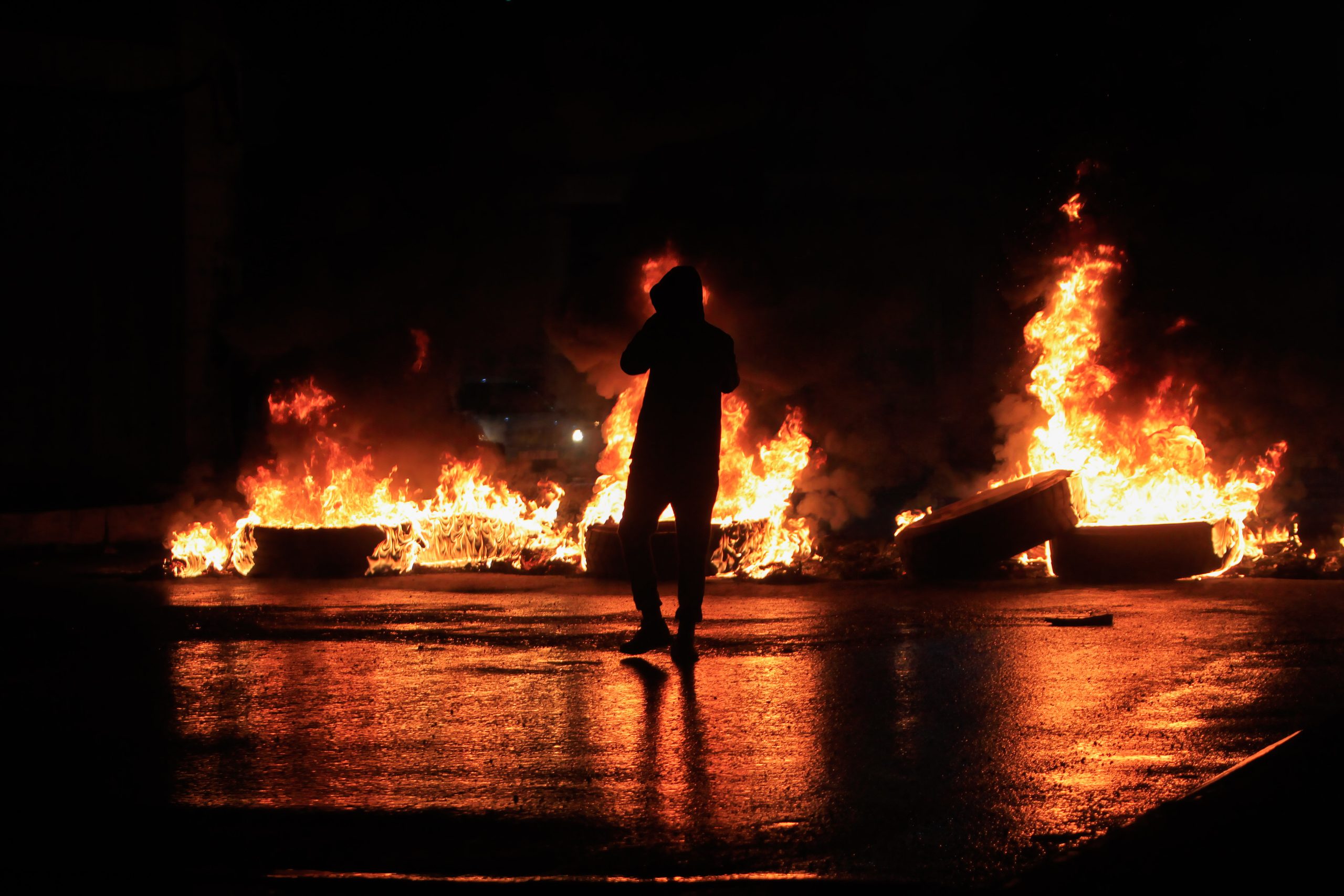
The vigorous offensive by the Israeli security establishment in Operation Break the Wave has increased the friction with armed young Palestinians. Nightly conflicts in Nablus
Photo: Nasser Ishtayeh / SOPA Images/Sipa
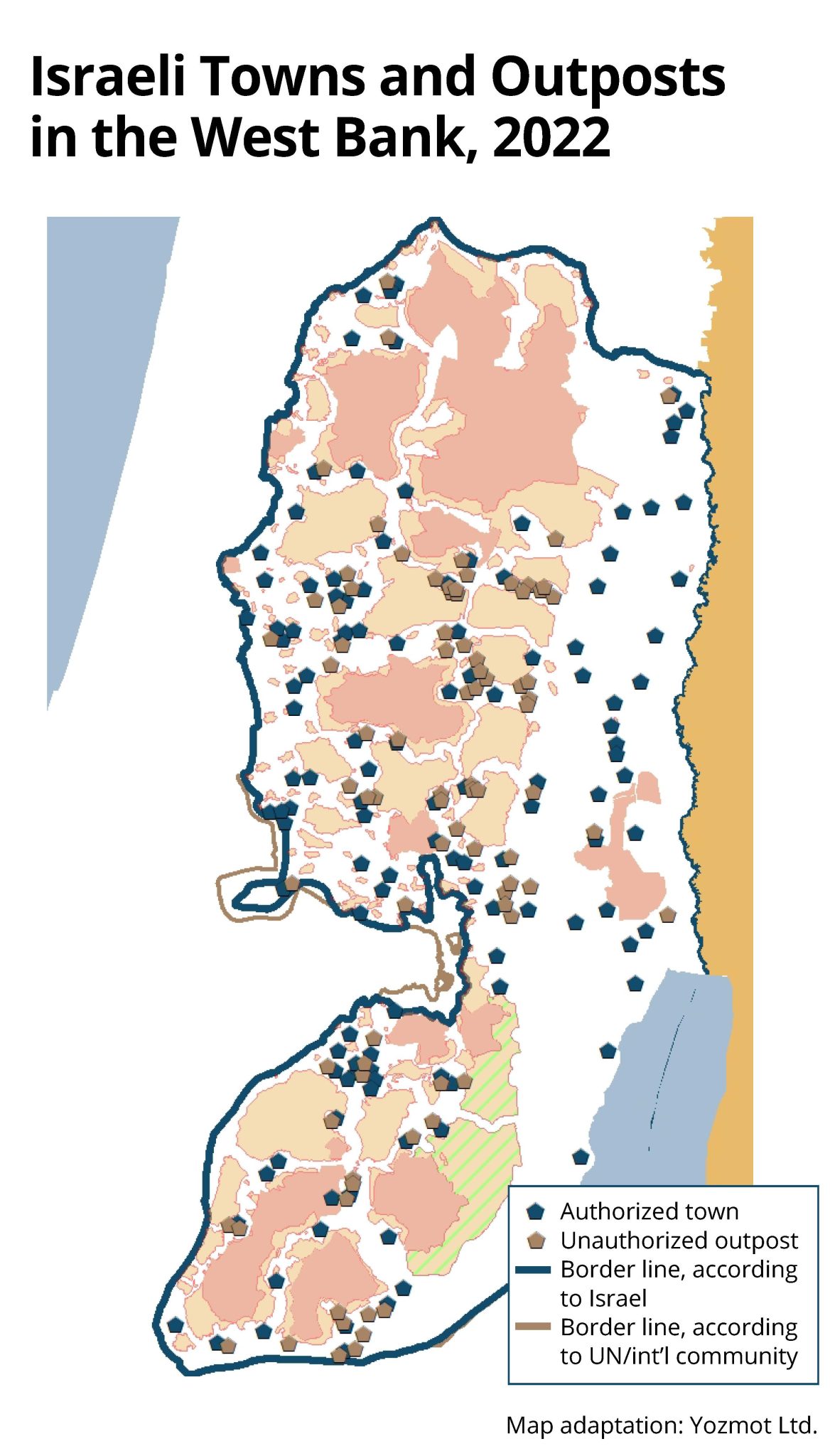
Jerusalem is highly volatile, and at the focus is the struggle over sovereignty at the Temple Mount. All aspects of the conflict converge around Jerusalem, and it is the main catalyst for escalation (including with the involvement of Arab-Muslim citizens of Israel). The increasing number of Jewish visitors to the Temple Mount in recent years, some of whom pray silently or openly, is sensed by the Muslim side as an invasion of the al-Aqsa Mosque, and in turn motivates many who see themselves as “defenders of al-Aqsa” – especially young Palestinians from East Jerusalem – to enlist in defending Muslim interests on the Temple Mount. The Israel Police allow an increased number of visits by tourists and by Jews to the Mount without coordinating with the Jordanian waqf, in violation of the status quo understandings – the historic achievement with the Kingdom of Jordan that enjoys international recognition. The religious contexts, as well as the significance of the demonstration of sovereignty on the Mount by one of the sides, makes the inherently sensitive site into a potentially explosive area, and any provocation could ignite it and prompt escalation in the other arenas as well.
In tandem, the conflict returns to the international arena. The decline in interest in the Palestinian issue in the regional system and the international community is expected to be reversed in light of the rise of a right-wing government in Israel, and especially if the government enacts annexation measures and exacerbates control and a belligerent approach in the West Bank. A range of challenges are expected in the international arena, including the advancement of a legal ruling on Israel’s policy in the West Bank by the International Court of Justice (ICJ) in The Hague, an investigation against Israel at the International Criminal Court (ICC), and the acceleration of BDS initiatives to boycott Israel. In this context, Israel’s dependence on the ability of the United States to curb and stave off initiatives against it is critical.

The increasing number of Jewish visitors to the Temple Mount is seen by the Muslim side as an invasion of the al-Aqsa Mosque. Minister of Internal Security Itamar Ben-Gvir visits the Temple Mount, January 2023
Photo: Twitter @itamarbengvir
These trends underscore that the Palestinian issue cannot be swept under the rug. The current policy – greater force in the West Bank ostensibly tempered by efforts at containment and an increased number of work permits for Palestinians in Israel – seems to be reaching its limits. The efforts at containment are undermined by creeping annexation measures, which could intensify with the establishment of the new government (which has already stopped the transfer of funds to the Palestinian Authority) and its declared intentions: amending the Disengagement Law; legalizing 65 illegal outposts; building in area E1, adjacent to Jerusalem on the east; transferring authority over the civil administration to a minister from the Religious Zionist Party; instructing the army to loosen the rules of engagement; and limiting the restraining power of the Supreme Court.
Possible Scenarios in the Coming Year:
- A rise in violence and chaos, especially in the West Bank; a popular uprising to the point of an armed popular uprising.
- The continued weakening of the Palestinian Authority until it loses control and influence over the West Bank.
- The continued and even accelerated decline in the legitimacy of Fatah and Hamas among the Palestinian public, and the consolidation of a growing camp of groups or operatives without organizational affiliation.
- Hamas continues to gain strength, scores political achievements in Gaza against the backdrop of reconstruction processes, and succeeds in attracting and bringing under its umbrella young Palestinians seeking to challenge Israel and undermine stability in PA territory.
- Given increasingly severe developments (along with the end of the Abbas era): international intervention, centered on a demand to allow elections to the Legislative Council and the PA presidency, including permission to vote in Jerusalem.
- Intra-Palestinian reconciliation – the reconciliation talks between Fatah and Hamas, under the title of “unity,” were renewed recently following the establishment of the right-wing government in Israel. Abbas, who insisted on the principle of “one gun, one law, one authority,” could agree – contravening his previous rejection – to form a unity government, due to the PA’s current weakness.
- The Palestinian arena has long been preparing for the day when Mahmoud Abbas will step down as president. Several scenarios could then develop. An optimistic scenario is an orderly leadership transition and the continued functioning of the Palestinian Authority, at least at its current level. The other scenarios are negative – from ongoing leadership struggles to the development of chaos and anarchy or the collapse of the Palestinian Authority.
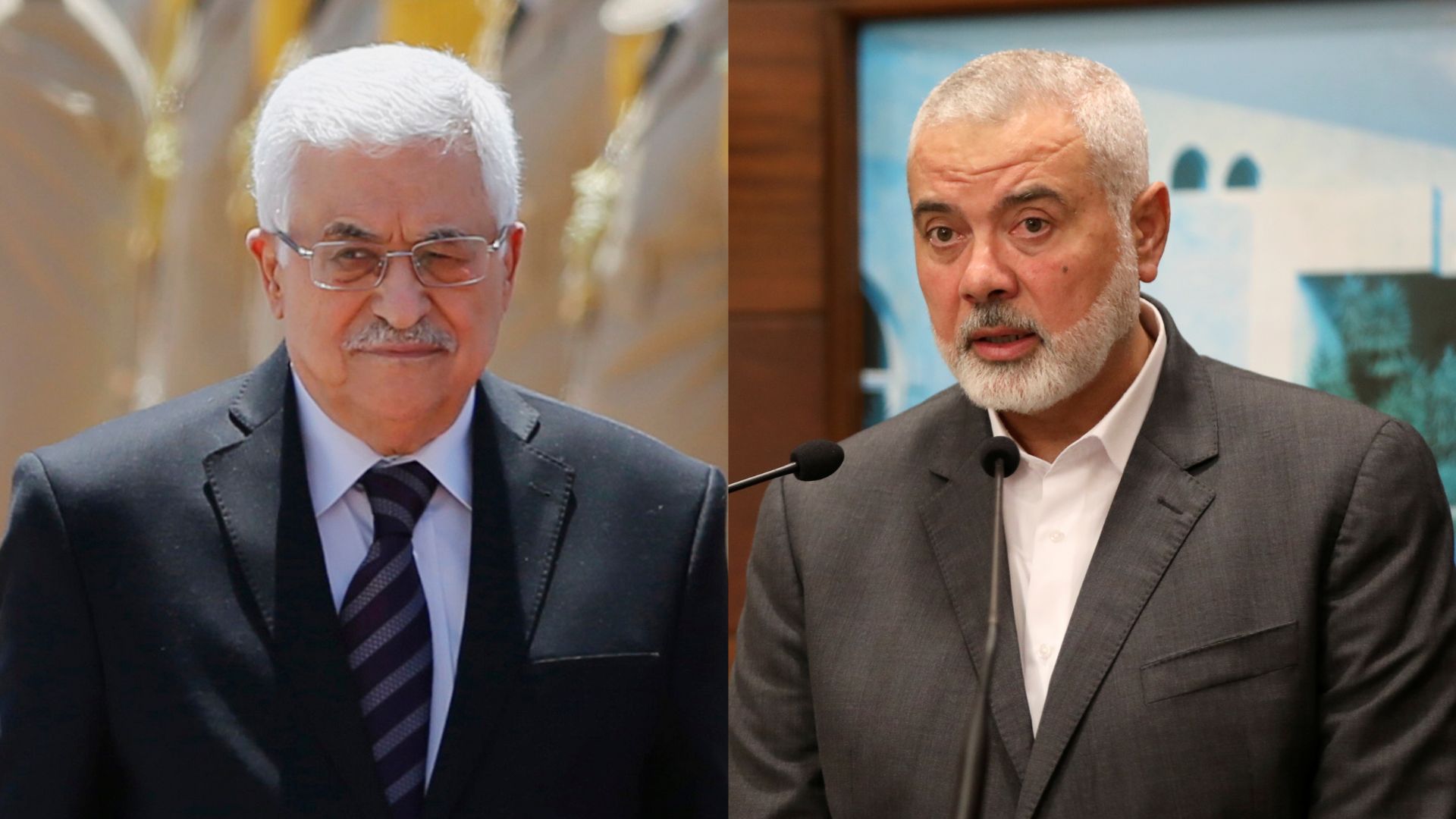
Toward Internal Palestinian reconciliation?Abu Mazen and Ismail Haniyeh
Photos: REUTERS (with INSS)
Policy Recommendations
Israel must cope simultaneously with two dangerous trends that reinforce one another:
- In the short term – increasing potential for an outbreak of armed violence in the Palestinian arena, following the developments of 2022 and in response to the emerging basic guidelines of the new government regarding the arena.
- In the medium and long terms – sliding into a one-state reality, which will not allow Israel to separate from the Palestinians in the future or exercise opportunities for a political agreement.
The Israeli strategic approach should be based on the premise that Israel is coping with two distinct, competing, and separate Palestinian entities – the Palestinian authority led by Fatah in the West Bank and Hamas in the Gaza Strip. The objective drafted in the past – restoring the authority over Gaza to the PA – has lost relevance because the PA, in conflict with Hamas, is unable and unwilling to take on the burden of Gaza. The condition that Abbas set for reconciliation is dismantling the military wing of Hamas, or at least subordinating it to the PA’s security forces, but this condition is not feasible without an Israeli military campaign against Hamas’s military wing. Furthermore, already today the PA has difficulty raising funds to manage Gaza in addition to the West Bank.
It is imperative to try to stop the dissolution of the Palestinian Authority, while strengthening and stabilizing it and maintaining its superiority over Hamas. The new Israeli government should acknowledge that efforts to neutralize the immediate security threats will only provide a temporary and partial response. Meantime, the potential for escalation mounts and over time a fundamental strategic change will be needed vis-à-vis the Palestinian Authority. In practical terms the government must continue to maintain the variety of channels of coordination with the Authority, in particular the security coordination. In an effort to prevent a popular Palestinian uprising, Israel must maintain the fabric of civilian life and refrain from acts of collective punishment, which could exacerbate economic hardship, increase frustration, especially among the younger generation, and further erode the willingness of the Palestinian security forces to cooperate in thwarting terrorism.
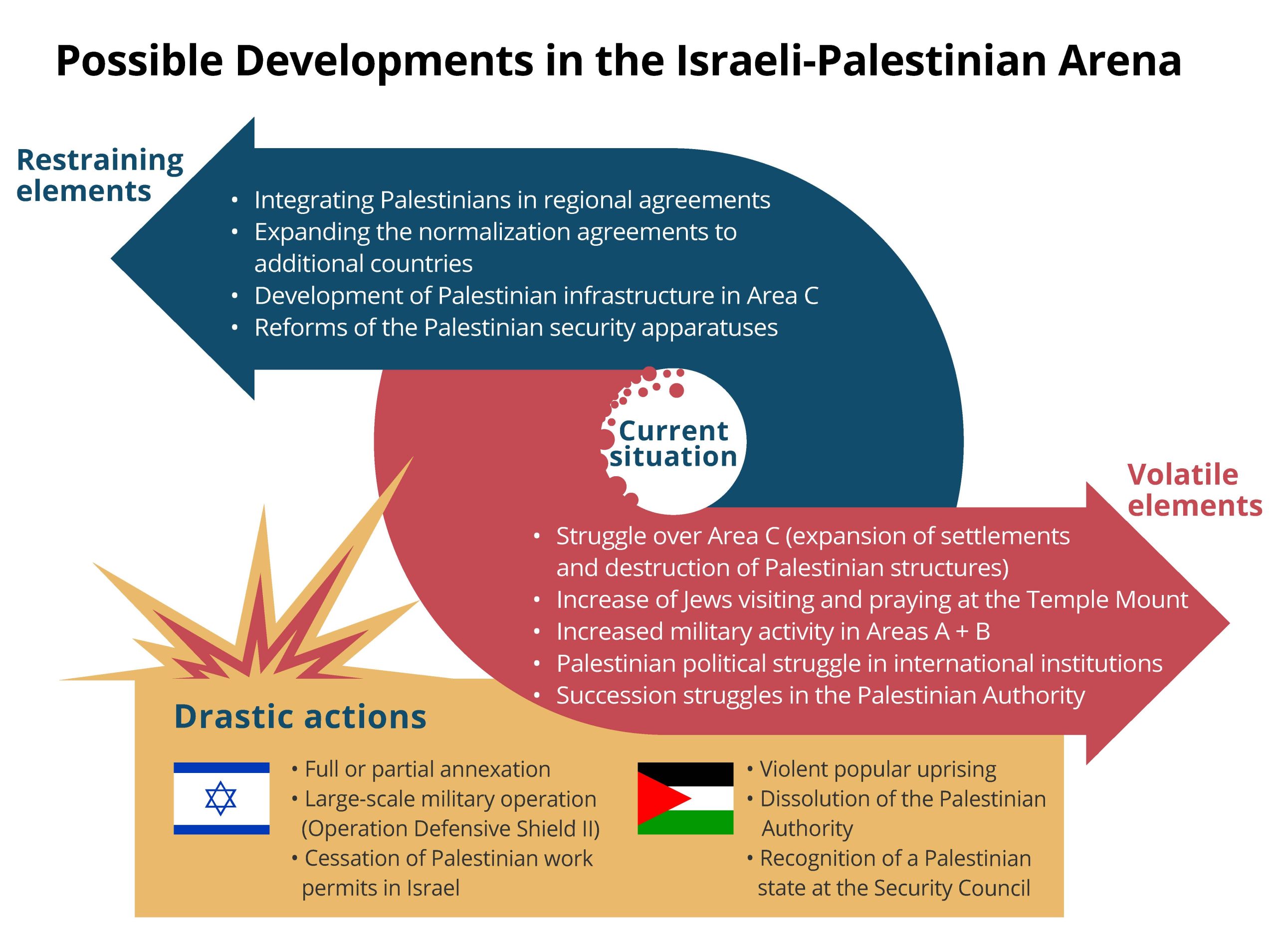
Volatility could intensify with implementation of policies of the new Israeli government, such as distancing Palestinians from Area C; encouraging a major increase in the number of Jews visiting the Temple Mount and allowing a Jewish prayer there; increasing military activity to thwart and dismantle terrorist infrastructure in PA territory; and expansion of construction in settlements and in sensitive areas such as E1. This could coincide with oppositional Palestinian activity to condemn and boycott Israel in international forums, alongside the weakening of the Palestinian Authority and the succession struggles. Therefore, to hedge the negative trends, Israel should take a series of restraining steps:
- Maintain security dialogue to outline relevant understandings for strengthening and stabilizing the governance of the Palestinian Authority, especially with an Israeli commitment to decrease IDF activity in PA territory, if and when the Palestinian security apparatuses fulfill their responsibility in the fight against terrorism, dismantle terrorist infrastructure, and impose law and order. Thus, it is important to help the PA implement reforms in the security forces to strengthen the effectiveness of their operation. Jordan and the US security coordinator (USSC) should be included in processes of building the operational doctrine, clearly defining responsibility and authority among the forces, instituting changes to the organizational structure, and providing training.
- If security calm and stability are achieved, it is suggested that the Israeli government – in contrast with the intention of changing the disengagement law – grant the Palestinian Authority full control of northern Samaria (an area in which there is no Jewish settlement). This step would show the Palestinians and the international community that Israel has not abandoned the vision of separating into two distinct entities and is willing to make territorial compromises. This would also transfer the burden of responsibility to the PA and force it to demonstrate control on the ground.
- Include the Palestinian Authority in regional agreements based on the Abraham Accords. In recent months, PA opposition to integration in regional initiatives has weakened, and there seems to be an understanding that it cannot “veto” relations between Israel and Arab countries. It is also possible that the PA’s inclusion in regional agreements would spur Saudi Arabia to join the Abraham Accords. Vis-à-vis the countries that are party to the Abraham Accords, Israel should examine the possibility of including the Palestinians in regional projects in a way that benefits the PA’s economy and governance, without harming Israel’s bilateral interests.
- Avoid constraining the growth of a new Palestinian leadership, based on local leaderships, businesspeople, academics, heads of student associations, and civil society groups. They can create islands of stability in the unraveling Palestinian camp, and an alternative leadership to the Fatah and Hamas movements might grow out of them.
- Israel must be careful about taking unilateral steps that could substantially change the reality in the conflict arena, particularly regarding the application of sovereignty (i.e., annexation) to territories in the West Bank, the establishment of new settlements, and the approval of illegal outposts. Annexation steps without the support of the United States – the Biden administration has already announced that it would oppose them – would incur negative consequences for Israel, especially serious damage to relations with the United States and Europe; harm the peace treaties with Jordan and Egypt, the Abraham Accords, and the ability to expand and deepen congenial relations; spur reconciliation efforts between Fatah and Hamas and cohesion surrounding violent resistance; promote a Palestinian demand to allow elections in the Palestinian Authority, including in Jerusalem; encourage international recognition (in the Security Council) of a Palestinian state within the 1967 borders whose capital is East Jerusalem; and increase condemnation of Israel in international forums, to the point of sanctions.
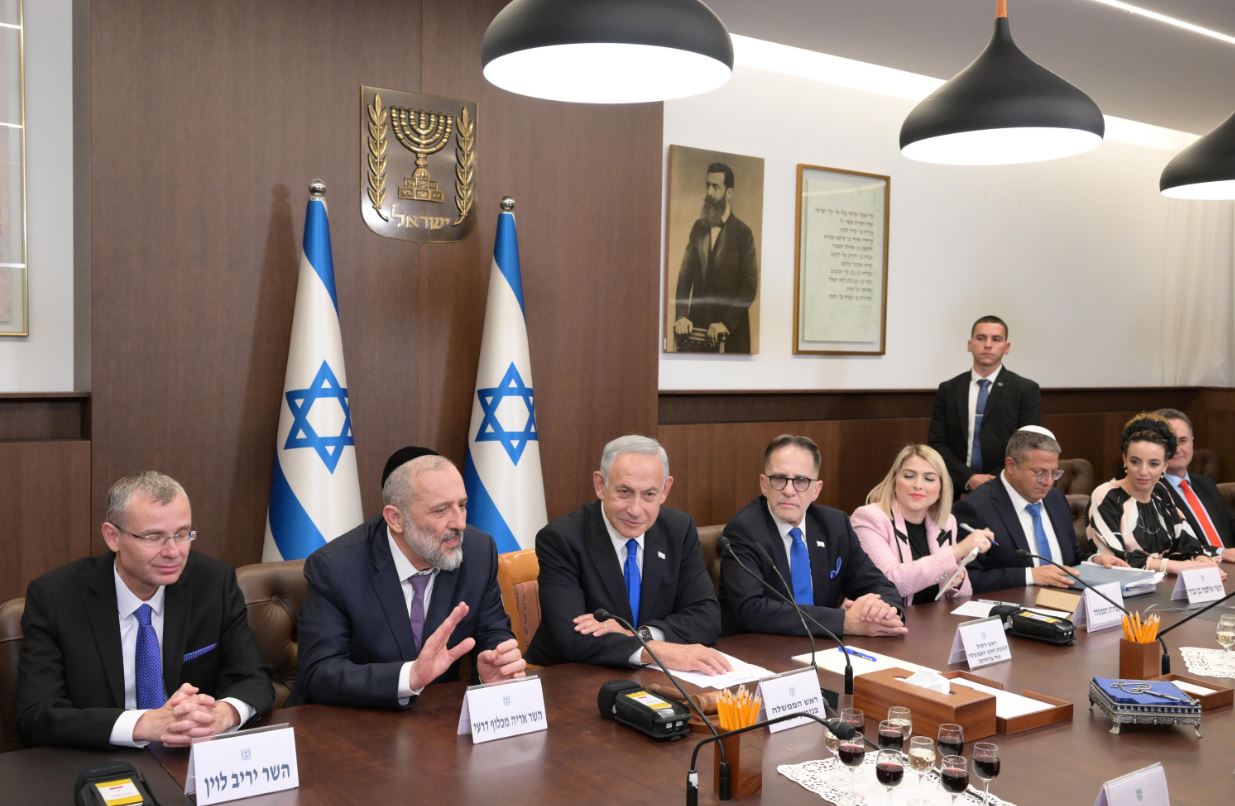
Israel must be careful about taking unilateral steps. The first meeting of Israel’s new government, December 2022
Photo: REUTERS/Ronen Zvulun
In a long-term perspective, the slide toward a one-state reality should be stopped (according to the INSS survey, some 80 percent of Israel’s citizens oppose a single binational state). In order to enable the future implementation of political options, it is critical to create conditions in the West Bank for political, geographic, and demographic separation between Israel and the Palestinian Authority (the same polls show that more than 60 percent of Israel’s citizens currently support separating from the Palestinians). In this framework, the following steps are necessary: restoring and completing the security barrier; drafting a plan for the settlement blocs and reducing construction beyond them; monitoring illegal construction and preventing the establishment of additional outposts; drafting master plans for separate Palestinian infrastructure in Area C and approving zoning plans for Palestinian communities; developing employment and industrial zones; improving the network of secondary roads; developing independent energy resources and Palestinian means of production; and reducing the areas of friction.
Regarding Hamas, the understandings on calm in Gaza should be continued, including economic and civilian benefits complemented by military resolve. In this framework, Israel should advance projects for the supply of natural gas, water desalination, sewage, and employment centers, and continue the entry of Gazan workers into Israel in return for a calm security situation and Hamas refraining from terrorism in Jerusalem and the West Bank. To consolidate the calm, it is essential to deepen the Egyptian involvement in Gaza: engage Egyptian leadership, with Israeli consent, for the construction of a port on the Egypt-Gaza border, under Egyptian-Palestinian operation and with international inspections; and position Egypt as the country connecting between Gaza and the Gulf countries, including the transfer of Qatari money to Gaza via Egypt and under its supervision (today only a third of the amount is transferred via Egypt). Egypt can recruit the Gulf countries for infrastructure projects in Gaza and use them as a restraining influence on Hamas.
At the same time, it is necessary to prepare a military campaign to neutralize Hamas’s strategic capabilities (missiles, rockets, drones, cyber, underground infrastructure).
Economic aid to the Palestinian Authority: The Palestinian economy is completely dependent on the Israeli economy. Ninety percent of exports and 55 percent of Palestinian imports are conducted with Israel, which employs about a fifth of the workforce in the West Bank. It is advisable to increase the PA tax income, enable effective collection of Palestinian income tax from workers employed in Israel, and integrate Palestinian customs officials for Palestinian goods at the ports and the Allenby crossing. Israel should advance plans to establish a designated dock for Palestinians at the Ashdod Port with a railway to the Tarqumiyah crossing, where a bonded land port will be established; approve infrastructure and transportation projects for Palestinians in Area C; promote initiatives for green energy, the environment, water, and climate; convey willingness to review sections of the Paris Protocol.
Economic measures are needed to develop the Palestinian economy toward separation, such as working to connect the Palestinian economy with other economies in the region, for the purpose of reducing dependence on the Israeli economy; work in Israel is essential to the Palestinian economy and contributes to a rise in the standard of living but undermines the standing of the Palestinian Authority in creating workplaces and collecting taxes. In the long term, it is necessary to strengthen Palestinian production, including by reducing work in Israel, and to increase the PA’s decision making capacity regarding its economic policy. Separation of infrastructure may be very expensive, but projects should be initiated with international funding toward separation.
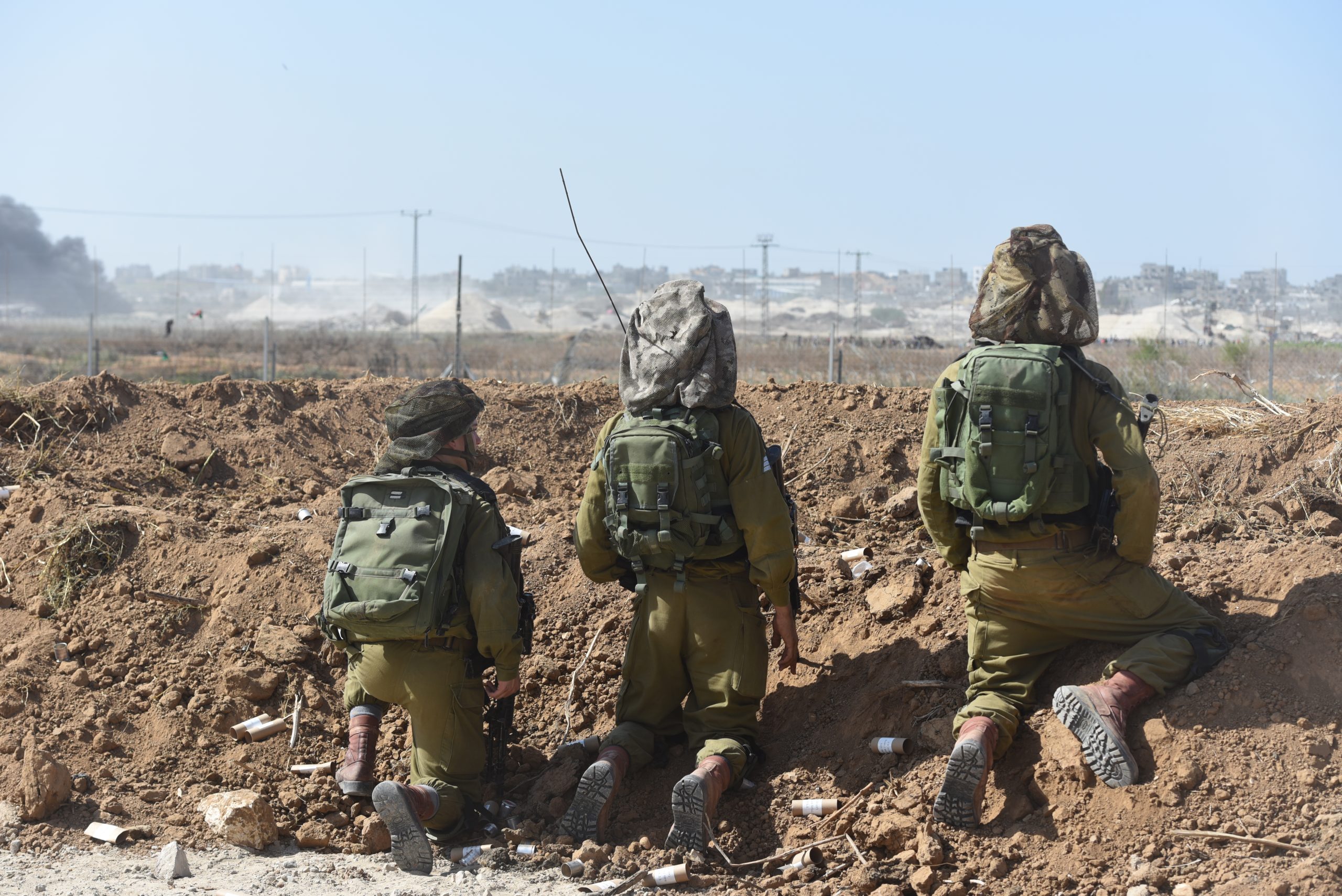
It is necessary to prepare a military campaign to neutralize Hamas’s strategic capabilities. IDF deployment along the Gaza Strip border
Photo: IDF Spokesperson’s Unit (CC BY-SA 2.0)
Special attention is needed to manage events in Jerusalem, to restrain sources of tension, contain violent outbreaks, and regulate the fabric of life that is shared by both the Jewish and Palestinian populations. To this end, the plan to improve the situation in East Jerusalem in education, employment, tourism, and infrastructure should be continued. Israel must decide whether to return to the status quo understandings or to strive for the formation of new understandings with Jordan, or alternatively, to create new facts on the ground at the Temple Mount and deal with the consequences. We recommend striving to reach an updated status quo on the Temple Mount with the Kingdom of Jordan, which takes into account the changes that have occurred in recent years at the site; establishing an advisory mechanism with the participation of experts – Jordanians, Palestinians, and Israelis (perhaps religious figures as well) – to manage the Temple Mount as a framework for dialogue, coordination, and cooperation surrounding the activity of visits and worship there. This mechanism would be a fixed channel of communication and dialogue for coordination and confidence building, and would encourage actions that calm the situation in advance of potentially volatile events, especially respective religious holidays.
________
Yohanan Tzoreff, Kobi Michael, Oded Eran, Pnina Sharvit Baruch, Orit Perlov, Haggay Etkes, Shira Efron, and Yoram Schweitzer contributed to this article.


